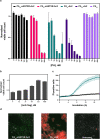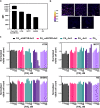Reengineering anthrax toxin protective antigen for improved receptor-specific protein delivery
- PMID: 32792013
- PMCID: PMC7427085
- DOI: 10.1186/s12915-020-00827-y
Reengineering anthrax toxin protective antigen for improved receptor-specific protein delivery
Abstract
Background: To increase the size of the druggable proteome, it would be highly desirable to devise efficient methods to translocate designed binding proteins to the cytosol, as they could specifically target flat and hydrophobic protein-protein interfaces. If this could be done in a manner dependent on a cell surface receptor, two layers of specificity would be obtained: one for the cell type and the other for the cytosolic target. Bacterial protein toxins have naturally evolved such systems. Anthrax toxin consists of a pore-forming translocation unit (protective antigen (PA)) and a separate protein payload. When engineering PA to ablate binding to its own receptor and instead binding to a receptor of choice, by fusing a designed ankyrin repeat protein (DARPin), uptake in new cell types can be achieved.
Results: Prepore-to-pore conversion of redirected PA already occurs at the cell surface, limiting the amount of PA that can be administered and thus limiting the amount of delivered payload. We hypothesized that the reason is a lack of a stabilizing interaction with wild-type PA receptor. We have now reengineered PA to incorporate the binding domain of the anthrax receptor CMG2, followed by a DARPin, binding to the receptor of choice. This construct is indeed stabilized, undergoes prepore-to-pore conversion only in late endosomes, can be administered to much higher concentrations without showing toxicity, and consequently delivers much higher amounts of payload to the cytosol.
Conclusion: We believe that this reengineered system is an important step forward to addressing efficient cell-specific delivery of proteins to the cytosol.
Keywords: Anthrax toxin; Cytosolic protein delivery; DARPin; Protective antigen.
Conflict of interest statement
The authors declare that they have no competing interests.
Figures




Similar articles
-
Anthrax Toxin Protective Antigen Variants That Selectively Utilize either the CMG2 or TEM8 Receptors for Cellular Uptake and Tumor Targeting.J Biol Chem. 2016 Oct 14;291(42):22021-22029. doi: 10.1074/jbc.M116.753301. Epub 2016 Aug 23. J Biol Chem. 2016. PMID: 27555325 Free PMC article.
-
Changing the receptor specificity of anthrax toxin.mBio. 2012 May 1;3(3):e00088-12. doi: 10.1128/mBio.00088-12. Print 2012. mBio. 2012. PMID: 22550037 Free PMC article.
-
The Disulfide Bond Cys255-Cys279 in the Immunoglobulin-Like Domain of Anthrax Toxin Receptor 2 Is Required for Membrane Insertion of Anthrax Protective Antigen Pore.PLoS One. 2015 Jun 24;10(6):e0130832. doi: 10.1371/journal.pone.0130832. eCollection 2015. PLoS One. 2015. PMID: 26107617 Free PMC article.
-
Anthrax toxin: receptor binding, internalization, pore formation, and translocation.Annu Rev Biochem. 2007;76:243-65. doi: 10.1146/annurev.biochem.75.103004.142728. Annu Rev Biochem. 2007. PMID: 17335404 Review.
-
Roles of Anthrax Toxin Receptor 2 in Anthrax Toxin Membrane Insertion and Pore Formation.Toxins (Basel). 2016 Jan 22;8(2):34. doi: 10.3390/toxins8020034. Toxins (Basel). 2016. PMID: 26805886 Free PMC article. Review.
Cited by
-
A Computational Investigation of In Vivo Cytosolic Protein Delivery for Cancer Therapy.Pharmaceutics. 2021 Apr 15;13(4):562. doi: 10.3390/pharmaceutics13040562. Pharmaceutics. 2021. PMID: 33921165 Free PMC article.
-
Thermodynamic Stability Is a Strong Predictor for the Delivery of DARPins to the Cytosol via Anthrax Toxin.Pharmaceutics. 2021 Aug 18;13(8):1285. doi: 10.3390/pharmaceutics13081285. Pharmaceutics. 2021. PMID: 34452246 Free PMC article.
-
Harnessing the Membrane Translocation Properties of AB Toxins for Therapeutic Applications.Toxins (Basel). 2021 Jan 6;13(1):36. doi: 10.3390/toxins13010036. Toxins (Basel). 2021. PMID: 33418946 Free PMC article. Review.
-
Intracellular Protein Delivery: Approaches, Challenges, and Clinical Applications.BME Front. 2024 Jan 25;5:0035. doi: 10.34133/bmef.0035. eCollection 2024. BME Front. 2024. PMID: 38282957 Free PMC article. Review.
-
Targeting the Inside of Cells with Biologicals: Toxin Routes in a Therapeutic Context.BioDrugs. 2023 Mar;37(2):181-203. doi: 10.1007/s40259-023-00580-y. Epub 2023 Feb 2. BioDrugs. 2023. PMID: 36729328 Free PMC article. Review.
References
Publication types
MeSH terms
Substances
Grants and funding
LinkOut - more resources
Full Text Sources

